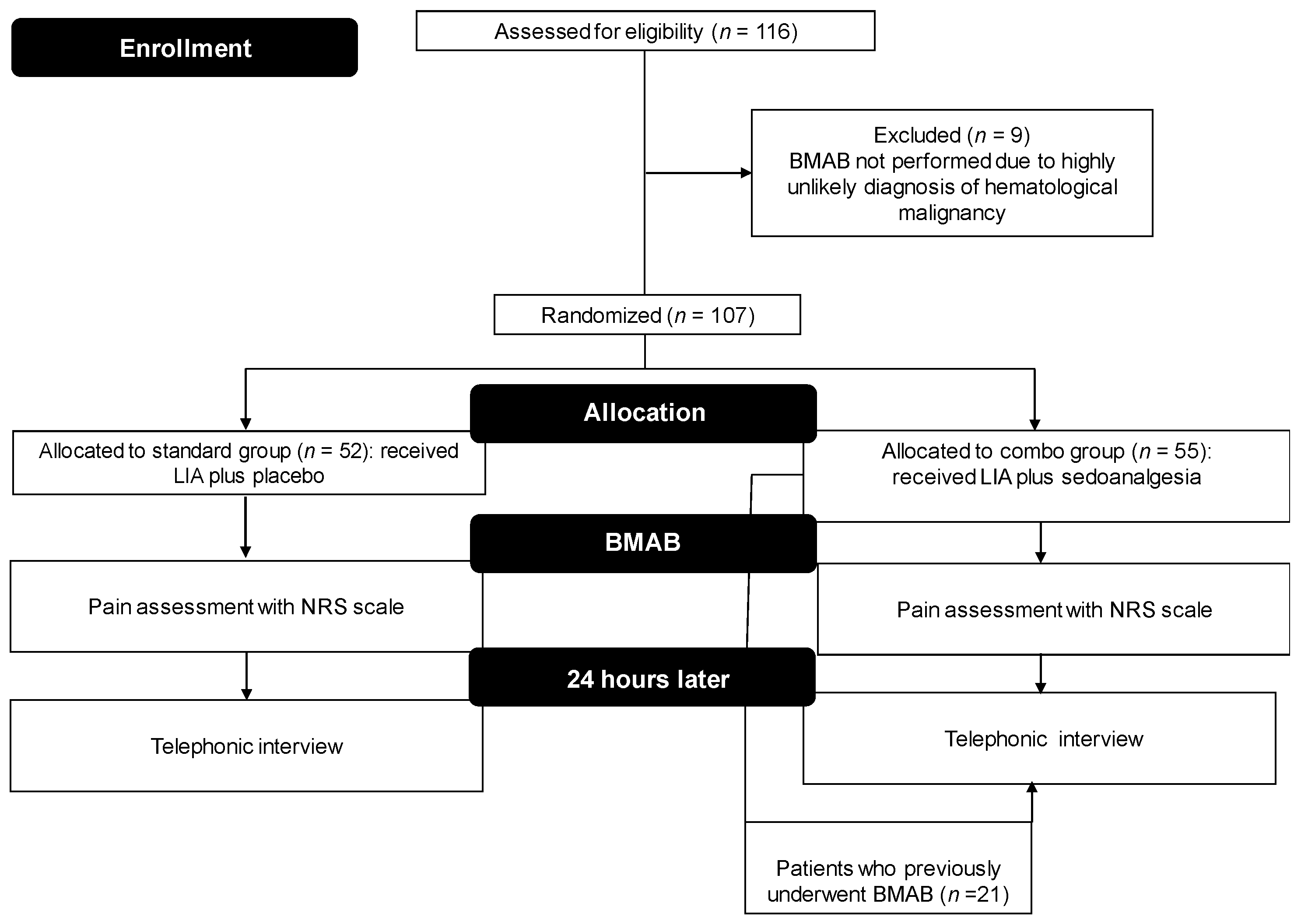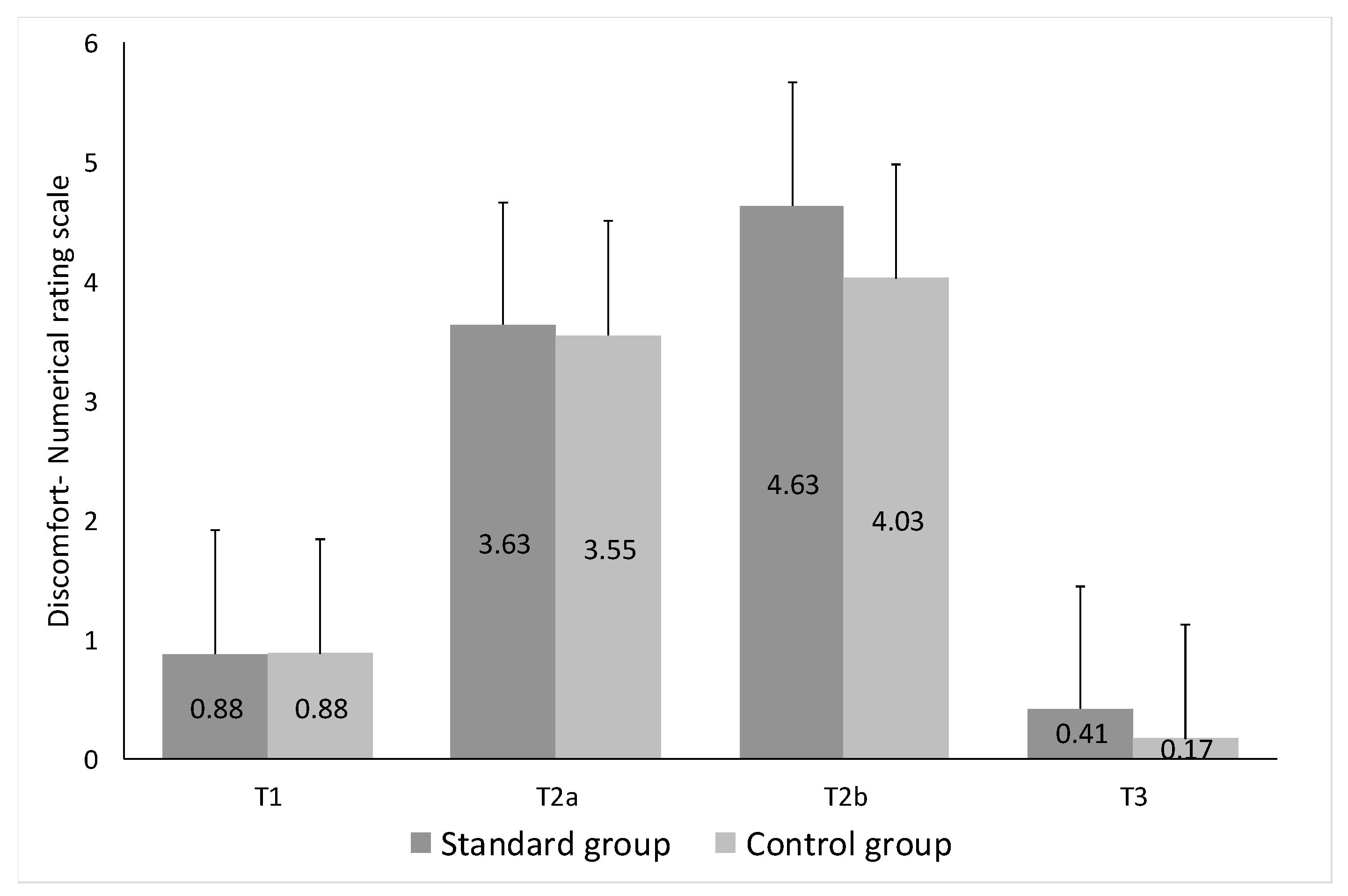Combined Oral Fentanyl Citrate and Midazolam as Premedication for Bone Marrow Aspiration and Biopsy in Patients with Hematological Malignancies: A Randomized, Controlled and Patient-Blinded Clinical Trial
Abstract
1. Introduction
2. Materials and Methods
2.1. Trial Design and Participants
2.2. Interventions
2.3. Pre-Procedural Interview
2.4. Primary and Secondary Outcomes
2.5. Sample Size
2.6. Randomization and Blinding
2.7. Statistical Analysis
3. Results
3.1. Participants and Recruitment
3.2. Efficacy
3.2.1. Questionnaires and Interview Results—Primary Endpoint
3.2.2. Effect on Cognition and Side-Effects—Secondary Endpoint
3.2.3. Ancillary Endpoints
3.2.4. Adequacy of BMAB—Harvested Specimens
4. Discussion
5. Conclusions
Author Contributions
Funding
Acknowledgments
Conflicts of Interest
References
- Bain, B.J. Bone marrow aspiration. J. Clin. Pathol. 2001, 54, 657–663. [Google Scholar] [CrossRef]
- Bain, B.J. Bone marrow trephine biopsy. J. Clin. Pathol. 2001, 54, 737–742. [Google Scholar] [CrossRef]
- Bain, B.J. Bone marrow biopsy morbidity: Review of 2003. J. Clin. Pathol. 2005, 58, 406–408. [Google Scholar] [CrossRef]
- Degen, C.; Christen, S.; Rovo, A.; Gratwohl, A. Bone marrow examination: A prospective survey on factors associated with pain. Ann. Hematol. 2010, 89, 619–624. [Google Scholar] [CrossRef] [PubMed]
- Mystakidou, K.; Katsouda, E.; Parpa, E.; Vlahos, L.; Tsiatas, M.L. Oral transmucosal fentanyl citrate: Overview of pharmacological and clinical characteristics. Drug. Deliv. 2006, 13, 269–276. [Google Scholar] [CrossRef] [PubMed]
- Farrar, J.T.; Cleary, J.; Rauck, R.; Busch, M.; Nordbrock, E. Oral transmucosal fentanyl citrate: Randomized, double-blinded, placebo-controlled trial for treatment of breakthrough pain in cancer patients. J. Natl. Cancer Inst. 1998, 90, 611–616. [Google Scholar] [CrossRef] [PubMed]
- Coluzzi, P.H.; Schwartzberg, L.; Conroy, J.D., Jr.; Charapata, S.; Gay, M.; Busch, M.A.; Chavez, J.; Ashley, J.; Lebo, D.; McCracken, M.; et al. Breakthrough cancer pain: A randomized trial comparing oral transmucosal fentanyl citrate (OTFC®) and morphine sulfate immediate release (MSIR). Pain 2001, 91, 123–130. [Google Scholar] [CrossRef]
- Moore, P.A.; Cuddy, M.A.; Magera, J.A.; Caputo, A.C.; Chen, A.H.; Wilkinson, L.A. Oral transmucosal fentanyl pretreatment for outpatient general anesthesia. Anesth. Prog. 2000, 47, 29–34. [Google Scholar] [PubMed]
- Ginsberg, B.; Dear, R.B.; Margolis, J.O.; Dear, G.D.; Ross, A.K. Oral transmucosal fentanyl citrate as an anaesthetic premedication when dosed to an opioid effect vs. total opioid consumption. Paediatr. Anaesth. 1998, 8, 413–418. [Google Scholar] [CrossRef] [PubMed]
- Milligan, D.W.; Howard, M.R.; Judd, A. Premedication with lorazepam before bone marrow biopsy. J. Clin. Pathol. 1987, 40, 696–698. [Google Scholar] [CrossRef] [PubMed]
- Dunlop, T.J.; Deen, C.; Lind, S.; Voyle, R.J.; Prichard, J.G. Use of combined oral narcotic and benzodiazepine for control of pain associated with bone marrow examination. South. Med. J. 1999, 92, 477–480. [Google Scholar] [CrossRef] [PubMed]
- Steedman, B.; Watson, J.; Ali, S.; Shields, M.L.; Patmore, R.D.; Allsup, D.J. Inhaled nitrous oxide (Entonox) as a short acting sedative during bone marrow examination. Clin. Lab. Haematol. 2006, 28, 321–324. [Google Scholar] [CrossRef] [PubMed]
- Gudgin, E.J.; Besser, M.W.; Craig, J.I.O. EntonoxTM as a sedative for bone marrow aspiration and biopsy. Int. J. Lab. Hematol. 2008, 30, 65–67. [Google Scholar] [PubMed]
- Vanhelleputte, P.; Nijs, K.; Delforge, M.; Evers, G.; Vanderschueren, S. Pain during bone marrow aspiration: Prevalence and prevention. J. Pain. Symptom. Manag. 2003, 26, 860–866. [Google Scholar] [CrossRef]
- Talamo, G.; Liao, J.; Bayerl, M.G.; Claxton, D.F.; Zangari, M. Oral administration of analgesia and anxiolysis for pain associated with bone marrow biopsy. Support. Care Cancer 2010, 18, 301–305. [Google Scholar] [CrossRef] [PubMed]
- Hjermstad, M.J.; Fayers, P.M.; Haugen, D.F.; Caraceni, A.; Hanks, G.W.; Loge, J.H.; Fainsinger, R.; Aass, N.; Kaasa, S.; European Palliative Care Research Collaborative (EPCRC). Studies comparing Numerical Rating Scales, Verbal Rating Scales, and Visual Analogue Scales for assessment of pain intensity in adults: A systematic literature review. J. Pain. Symptom. Manag. 2011, 41, 1073–1093. [Google Scholar] [CrossRef] [PubMed]
- Swerdlow, S.H.; Campo, E.; Harris, N.L.; Jaffe, E.S.; Pileri, S.A.; Stein, H.; Thiele, J.; Vardiman, J.W. WHO Classification of tumours of haematopoietic and lymphoid tissues, 4th ed.; IARC Press: Lyon, France, 2008. [Google Scholar]
- Talamo, G.; Liao, J.; Joudeh, J.; Lamparella, N.E.; Dinh, H.; Malysz, J.; Ehmann, W.C. Perceived levels of pain associated with bone marrow aspirates and biopsies. J. Support. Oncol. 2012, 10, 166–170. [Google Scholar] [CrossRef] [PubMed]
- Hjortholm, N.; Jaddini, E.; Hałaburda, K.; Snarski, E. Strategies of pain reduction during the bone marrow biopsy. Ann. Hematol. 2013, 92, 145–149. [Google Scholar] [CrossRef] [PubMed]
- Park, S.H.; Bang, S.M.; Nam, E.; Cho, E.K.; Shin, D.B.; Lee, J.H.; Ahn, J.Y. A randomized double-blind placebo-controlled study of low-dose intravenous Lorazepam to reduce procedural pain during bone marrow aspiration and biopsy. Pain Med. 2008, 9, 249–252. [Google Scholar] [CrossRef] [PubMed]


| Patient Characteristics | Standard Group | Combo Group |
|---|---|---|
| No. of patients | 52 | 55 |
| Male/Female | 25/27 | 26/29 |
| Median age, years (range) | 61 (19–84) | 60 (21–82) |
| Type of hematologic malignancy | ||
| Non-Hodgkin’s lymphoma | 24 | 20 |
| Essential thrombocythemia | 8 | 11 |
| Polycythemia vera | 8 | 10 |
| Hodgkin’s lymphoma | 6 | 7 |
| Primary myelofibrosis | 4 | 4 |
| Chronic myeloid leukemia | 2 | 3 |
| Endpoint | Standard Group | Combo Group |
|---|---|---|
| NRS Pain Assessment | ||
| T1 | 0.87 | 0.88 |
| T2a | 3.63 | 3.54 |
| T2b | 4.63 | 4.0 |
| T3 | 0.41 | 0.16 |
| Painful experience recalling 1 | 52 (100%) | 0 |
| Opioid side effects 1 | 0 | 2 (3.63%) |
| Specimen medium lenght (mm) | 17.9 | 21.2 |
| Conclusive histologic diagnosis 1 | 48 (92.3%) | 55 (100%) |
| Actiq® | Midazolam | Biopsy Needle | Total Charge | Total Charge Per Patient | Total Net Charge Difference | Net Charge Difference Per Patient | |
|---|---|---|---|---|---|---|---|
| Standard group | - | - | 1568 | 1568 | 30.15 | - | - |
| Combo group | 266 | 56.375 | 1540 | 1862.375 | 33.85 | +294.375 | +3.7 |
© 2020 by the authors. Licensee MDPI, Basel, Switzerland. This article is an open access article distributed under the terms and conditions of the Creative Commons Attribution (CC BY) license (http://creativecommons.org/licenses/by/4.0/).
Share and Cite
Cerchione, C.; Martinelli, G.; Picardi, M.; Pugliese, N.; Nappi, D.; Casoria, A.; Gravetti, A.; Cangini, D.; Giannini, M.B.; Ronconi, S.; et al. Combined Oral Fentanyl Citrate and Midazolam as Premedication for Bone Marrow Aspiration and Biopsy in Patients with Hematological Malignancies: A Randomized, Controlled and Patient-Blinded Clinical Trial. J. Clin. Med. 2020, 9, 395. https://doi.org/10.3390/jcm9020395
Cerchione C, Martinelli G, Picardi M, Pugliese N, Nappi D, Casoria A, Gravetti A, Cangini D, Giannini MB, Ronconi S, et al. Combined Oral Fentanyl Citrate and Midazolam as Premedication for Bone Marrow Aspiration and Biopsy in Patients with Hematological Malignancies: A Randomized, Controlled and Patient-Blinded Clinical Trial. Journal of Clinical Medicine. 2020; 9(2):395. https://doi.org/10.3390/jcm9020395
Chicago/Turabian StyleCerchione, Claudio, Giovanni Martinelli, Marco Picardi, Novella Pugliese, Davide Nappi, Aniello Casoria, Angela Gravetti, Delia Cangini, Maria Benedetta Giannini, Sonia Ronconi, and et al. 2020. "Combined Oral Fentanyl Citrate and Midazolam as Premedication for Bone Marrow Aspiration and Biopsy in Patients with Hematological Malignancies: A Randomized, Controlled and Patient-Blinded Clinical Trial" Journal of Clinical Medicine 9, no. 2: 395. https://doi.org/10.3390/jcm9020395
APA StyleCerchione, C., Martinelli, G., Picardi, M., Pugliese, N., Nappi, D., Casoria, A., Gravetti, A., Cangini, D., Giannini, M. B., Ronconi, S., Simonetti, G., Ghelli Luserna Di Rorà, A., De Giorgi, U., Altini, M., Bravaccini, S., Santoriello, I., Minucci, C., Pane, F., & Martinelli, V. (2020). Combined Oral Fentanyl Citrate and Midazolam as Premedication for Bone Marrow Aspiration and Biopsy in Patients with Hematological Malignancies: A Randomized, Controlled and Patient-Blinded Clinical Trial. Journal of Clinical Medicine, 9(2), 395. https://doi.org/10.3390/jcm9020395










